Craving a warm, comforting bowl of authentic Punjabi Rajma? You’ve landed in just the right place! This traditional North Indian dish, known for its hearty flavor and wholesome ingredients, is a staple in many Indian households. Punjabi Rajma Masala is a rich and flavorful curry made using red kidney beans, slowly cooked in an onion-tomato gravy infused with aromatic spices. It’s not just delicious but also incredibly satisfying and nourishing.

What makes this rajma masala truly special is its simplicity—no fancy ingredients, no complex techniques—just a handful of basic kitchen staples and a bit of patience to let the flavors develop. Pair it with perfectly steamed basmati rice to create Rajma Chawal—a classic comfort food that brings homey warmth and nostalgic flavors in every bite.
Whether you’re cooking for your family or treating guests to a soulful Indian meal, this rajma recipe promises to be a crowd-pleaser. So, roll up your sleeves and let’s get started on making this timeless Punjabi favorite that’s as satisfying to cook as it is to eat!
About This Rajma Recipe
Rajma Chawal is a beloved North Indian classic, especially cherished in Punjabi households, where it’s often enjoyed as part of a weekend comfort food ritual. To begin with, tender red kidney beans (rajma) are pressure-cooked until soft. Then, they are gently simmered in a rich, spiced onion-tomato base, which is bursting with bold Punjabi flavors. Traditionally, this flavorful rajma masala is served with steamed white rice. Additionally, a side of sliced onions or lemon wedges completes the meal, making it truly soul-satisfying.
Taste & Texture:
- Taste: This version of rajma masala is moderately spiced, full of flavor, and carries the signature depth and warmth of Punjabi-style red gravy.
- Texture: The gravy is thick and luscious with a slightly coarse texture from the slow-cooked onions and tomatoes, perfectly complementing the creamy, tender kidney beans that simply melt in your mouth.
Why You’ll Love This Rajma Recipe
Perfect for Meal Prep:
Prepare a generous portion of this rajma masala for dinner, and you’ll have a ready-made, flavorful lunch the next day. As it rests overnight, the spices blend beautifully, enhancing the taste and making it even more delicious when reheated!
Nutritious & Wholesome:
Rajma Chawal isn’t just comforting—it’s also a powerhouse of nutrition. Kidney beans are packed with plant-based protein, essential minerals like iron, copper, phosphorus, manganese, and molybdenum, as well as vitamins such as B1 and folate. Though high on the glycemic index (GI), rajma provides slow-digesting carbohydrates that support gut health and keep you full longer. When paired with rice, the combination forms a complete protein by including all nine essential amino acids, making it an ideal vegetarian meal for sustained energy and well-being.
Ingredient Notes For Rajma Masala:
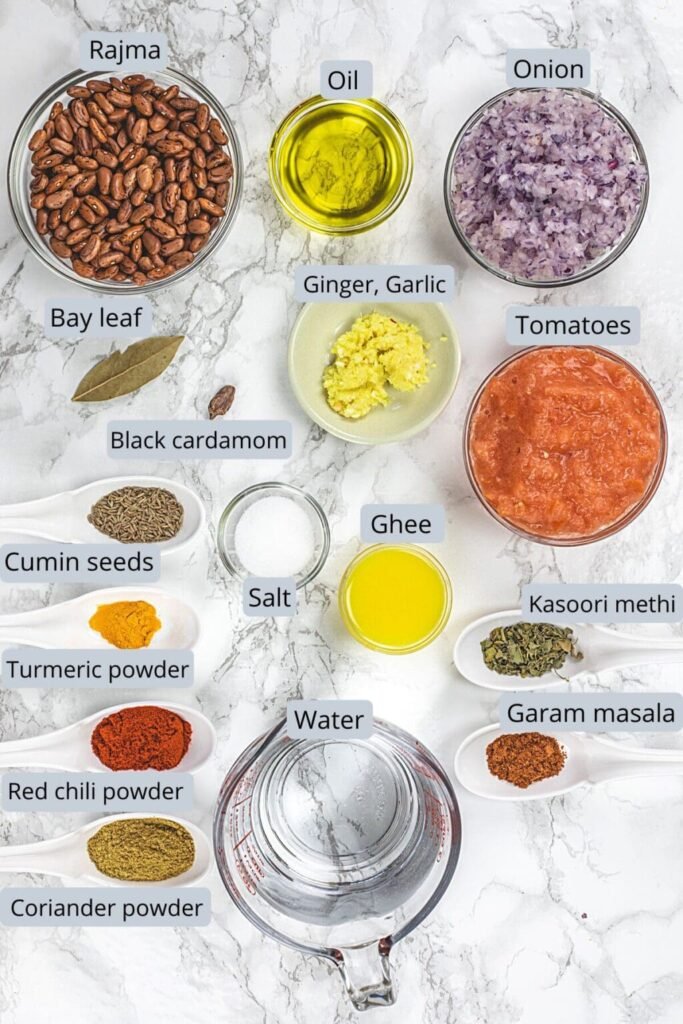
- Rajma (Kidney Beans): Various types are available in stores. Choose based on texture and taste preference:
- Chitra Rajma: Punjabi households most commonly use creamy beige beans with maroon streaks. Once cooked, they turn exceptionally soft and creamy, perfect for comforting rajma curry.
- Red Rajma (Kidney Beans): More readily available in international and American markets. These are deeper red, firmer after cooking, and hold their shape well. I’ve used these in recipes like kidney bean burgers.
- Jammu Rajma: These beans resemble red rajma in color but are noticeably smaller in size. Known for their rich taste and distinct aroma, they are cultivated in the Jammu & Kashmir region and are often preferred for their superior flavor and quicker cooking time. Known for their aroma and rich flavor, these are native to Jammu & Kashmir and add an earthy depth to the dish.
- Onions: Traditionally, red onions were grated by hand for a smooth masala base. To speed up the process, I prefer using a food processor, which helps replicate the traditional texture in much less time.
- Tomatoes: Earlier, tomatoes were hand-grated with skins removed. I use Roma or plum tomatoes in a food processor to get a coarse puree that works perfectly for this gravy.
- Ginger & Garlic: Punjabi cooking uses generous amounts. I blend them together into a paste using the wet jar of a spice grinder for robust flavor.
- Whole Spices: Bay leaf and black cardamom bring depth and a subtle smoky fragrance to the dish.
- Cumin Seeds: They’re added not just for their flavor, but also because they support digestion, especially helpful when preparing legume-based dishes like rajma.
- Ground Spices: Basic spices like turmeric, red chili powder, coriander powder, garam masala, and crushed kasoori methi bring out the true Punjabi essence.
- Ghee or Butter: Stirred in at the end for richness and aroma.
- Fresh Cilantro: Used for garnish to add brightness and freshness to the final dish.
How To Make Rajma Masala?
Soaking & Cooking Rajma & Rice:
1) Clean the Rajma: Place red kidney beans in a large bowl. Rinse them well 2–3 times under cold water, gently massaging with your fingers until the water runs clear. Continue until the water runs clear.
2) Soak the Beans: Cover the beans with plenty of water—about 2 to 3 inches above their level. Soak for at least 8 hours or overnight. The beans will swell up and increase to almost twice their original size.

3) Drain and Prep for Cooking: Discard the soaking water. Transfer the soaked beans into the steel insert of your Instant Pot or pressure cooker. Pour in fresh water and add a pinch of salt.
4) Prepare the Rice: Wash the rice just like the beans, rinsing until the water is no longer cloudy. Transfer the washed rice into a different container or cooking pot. Pour in water, a pinch of salt, and a small amount of ghee. If you’re using a stovetop pressure cooker, cook the rice separately in a saucepan as you would in a regular basmati rice recipe.

5, 6, 7) Stack in the Cooker: Pour one glass of water into the base of your electric pressure cooker. Place a trivet or rack inside. Set the bean insert on the rack and stack the rice container on top. Cover the rice insert with a lid to prevent steam from entering directly.
8) Pressure Cooking Time:
- For stovetop pressure cooking, start by cooking on high heat until you hear one whistle. After that, reduce the heat and let it simmer for 10 minutes.
- Instant Pot: Select the ‘Pressure Cook’ or ‘Manual’ setting, set it to high pressure, and cook for 8 minutes.
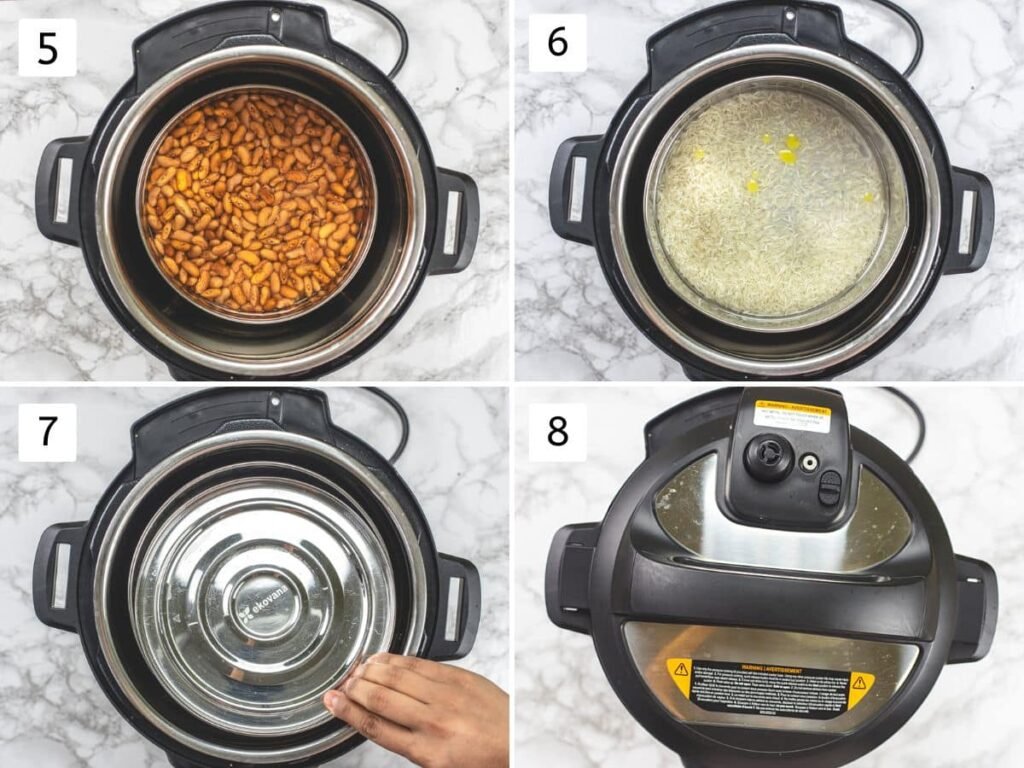
9) Release Pressure and Fluff Rice: Let the pressure release naturally. Gently unlock and lift the lid, take out the rice vessel, and lightly fluff the rice with a fork. Keep it covered until serving.
10) Check Rajma for Doneness: Test a few beans by pressing them between your fingers—they should feel soft and mash easily. Some beans may even split open, indicating they are perfectly cooked.

Making Rajma Masala:
1) Heat some oil in a pan over medium flame. When the oil is heated, add the bay leaf and black cardamom to the pan. Cook them for about 30 seconds until their aroma is released.
2) Add Cumin Seeds: Toss in the cumin seeds and let them crackle briefly.

3) Sauté Onions with Salt: Add finely chopped onions along with a pinch of salt to help them cook faster.
4) Cook Until Deep Brown: Stir frequently and continue cooking until the onions turn deep brown. This step is crucial for developing rich flavor—don’t stop when they’re just soft and pink. Medium heat is best for slow caramelization without burning.
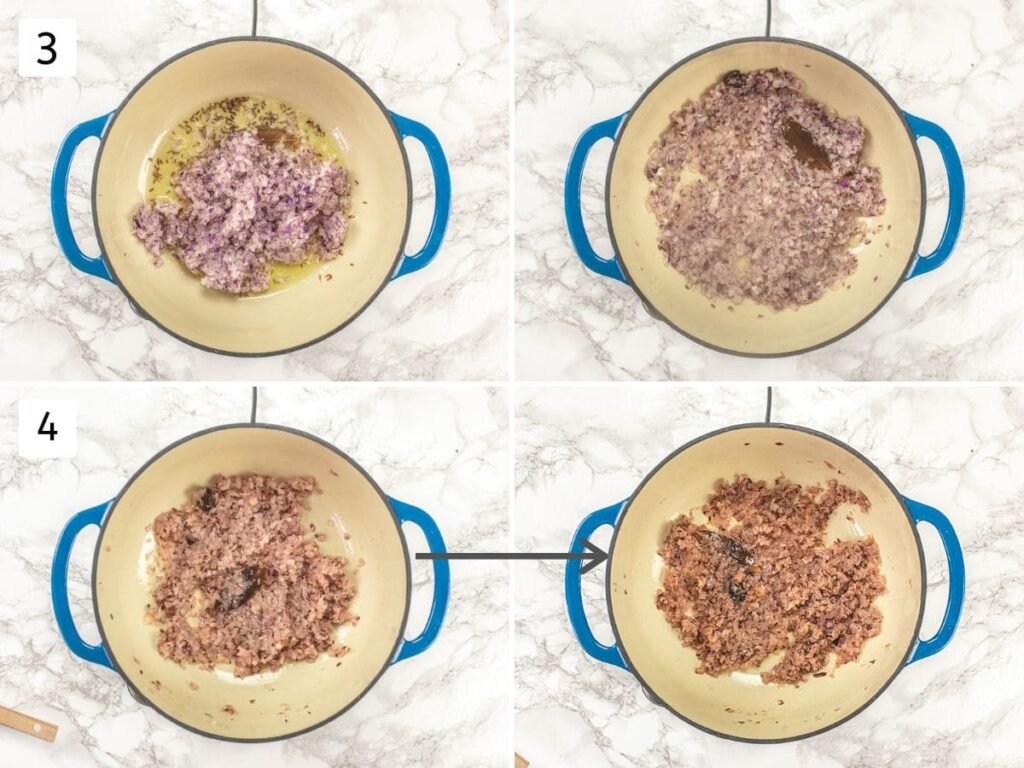
5, 6) Add Ginger-Garlic Paste: Stir in the ginger and garlic paste. Cook for a minute or until the raw smell fades away.

7, 8) Incorporate Tomatoes: Add the crushed or pureed tomatoes to the pan. Mix well.
9) Cook Down the Tomatoes: Continue sautéing until the mixture thickens and turns paste-like, with no excess moisture. This process, known as bhuna in Hindi, is essential in Punjabi cooking for a deep, well-rounded flavor.
10) Add Ground Spices: Sprinkle in turmeric, red chili powder, and coriander powder. Stir and cook for a minute, or until you see oil starting to separate at the edges of the masala.

11) Add the boiled rajma along with the cooking liquid into the pan. Season with the remaining salt.
12, 13) Simmer the Gravy: Stir well and bring it to a boil. Next, reduce the heat and allow it to simmer for about 15 minutes, until the curry thickens. Meanwhile, stir occasionally to prevent it from sticking.
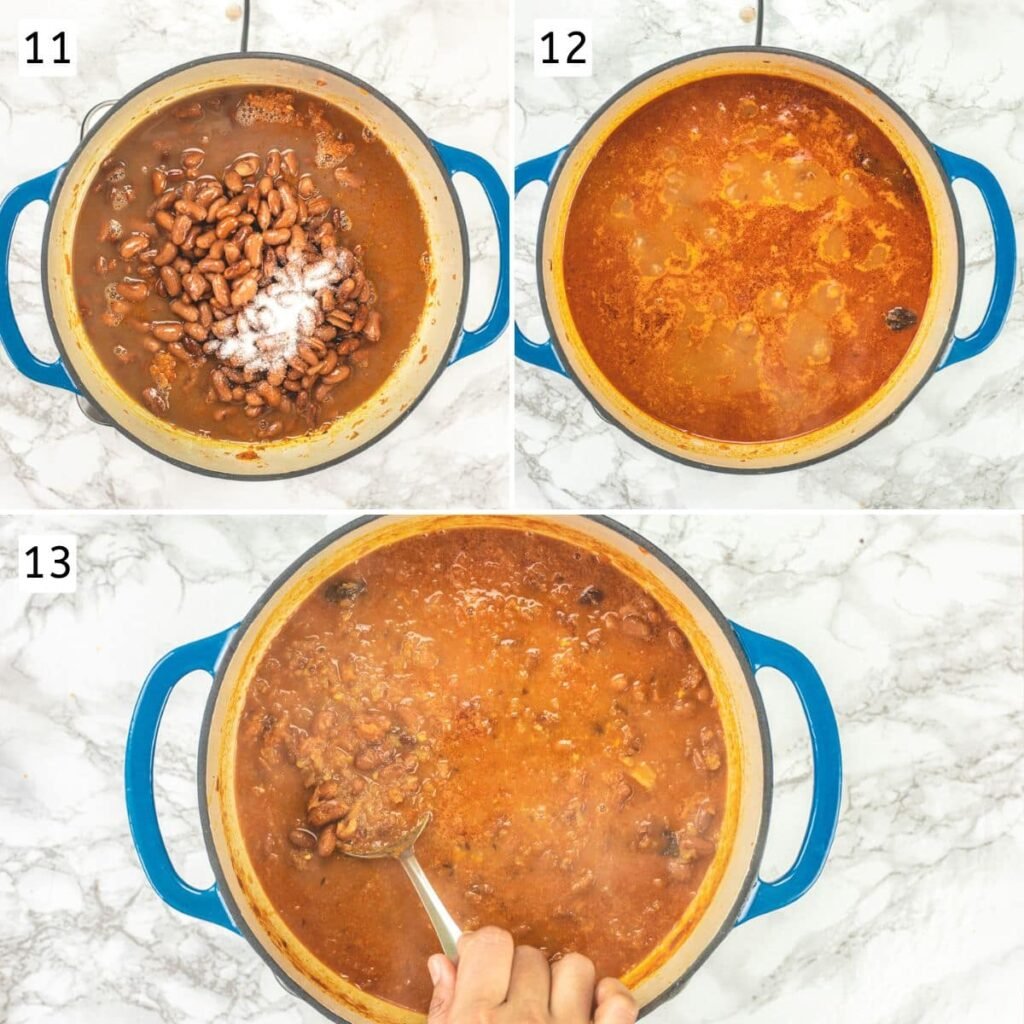
14) Finish with Spices: Add garam masala and crushed kasoori methi. Mix to blend the flavors.
15, 16) Add Ghee: Drizzle in ghee, allow it to melt into the curry, and stir well.
17) Finally, garnish with freshly chopped cilantro to add a burst of freshness before serving.
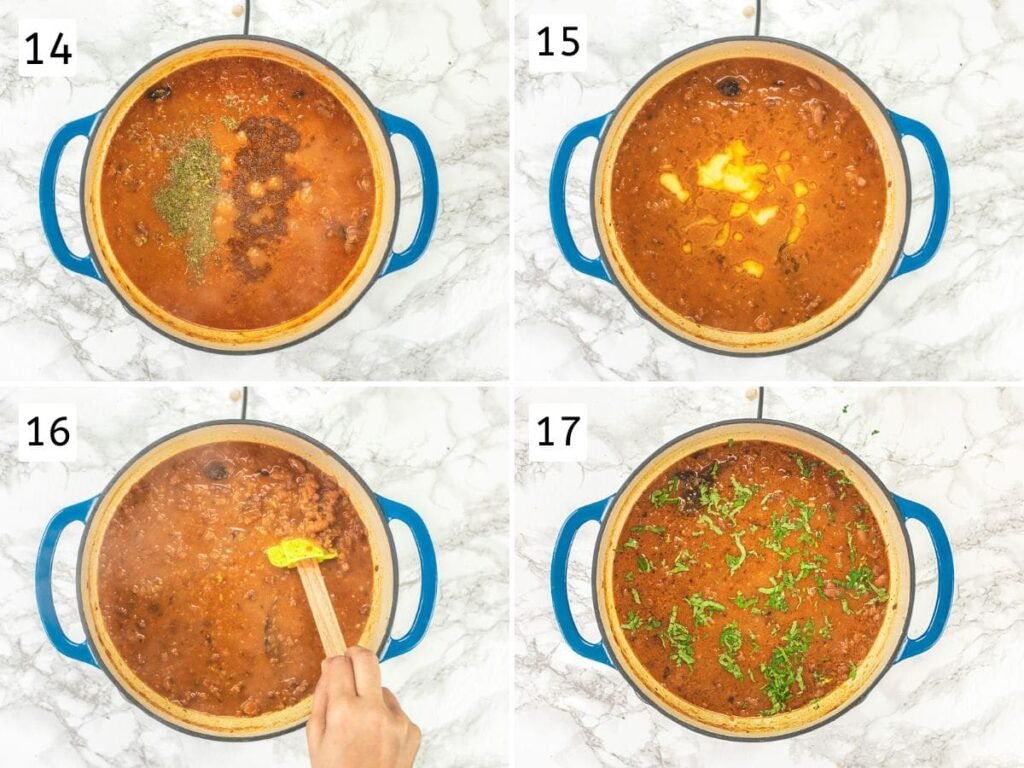
Serving Ideas For Rajma Masala:
- Classic Rajma Chawal: The most traditional and beloved way to enjoy Punjabi rajma is with plain steamed basmati rice, fondly known as rajma chawal. The soft texture of rice pairs beautifully with the rich, spiced rajma gravy, making it a comforting and hearty meal.
- With Jeera Rice: For an extra layer of flavor, serve rajma with jeera rice (cumin-flavored rice). The mild nuttiness of cumin complements the robust spices in the curry and turns a simple dish into a festive meal.
- Alongside Mild Pulao: Rajma also pairs well with lightly spiced rice varieties like peas pulao or vegetable pulao. These subtle rice dishes don’t overpower the curry and allow the rajma masala to shine.
- With Indian Breads: Rajma typically pairs with rice, but it also creates a satisfying meal when you serve it with Indian breads. Serve it with freshly made roti, phulka, or even tandoori roti for a wholesome combination. Alternatively, you can enjoy it with crispy parathas for a richer, more indulgent option.
- Accompaniments That Elevate the Meal:
- Enhance your meal with simple yet flavorful sides like:
- Laccha Pyaaz (sliced onion rings with lemon and salt) – for crunch and sharpness.
- Roasted or fried papad – adds a crispy element to the soft texture of rajma.
- Kachumber salad – a light and refreshing blend of diced cucumber, tomatoes, and onions tossed with a splash of lemon juice.
- Mango or lemon pickle – adds a tangy kick that balances the curry’s richness.
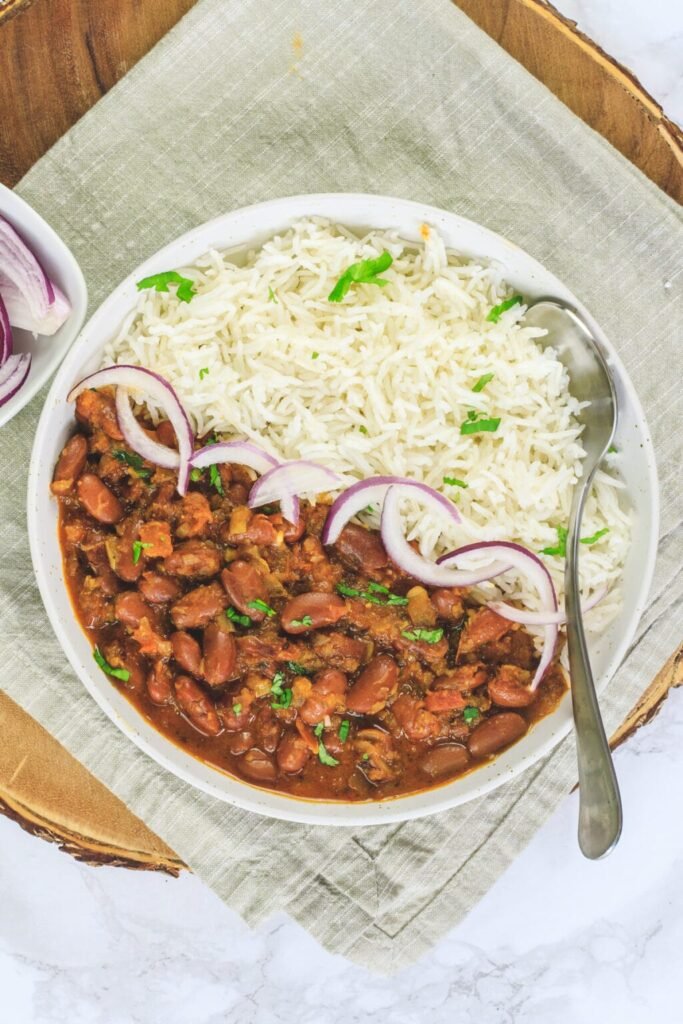
Expert Tips To Make the BEST Rajma Recipe
- Bhuna Masala Matters: Cooking the onion and tomato mixture well is essential for depth of flavor. First, cook the onions over medium-low heat until they turn a rich golden brown. Then, simmer the tomatoes until all the moisture evaporates and the mixture thickens into a flavorful paste.
- Always Soak the Beans: Soaking kidney beans overnight shortens the cooking time, preserves nutrients, and improves digestion. It also results in a soft, creamy texture.
- To deepen the flavor, allow the curry to simmer on low heat for at least 15 minutes after adding the beans. Consequently, the rajma soaks up the masala beautifully, and the gravy becomes rich and thick.
- Using Canned Rajma: If using canned kidney beans (two 15-oz cans), skip the soaking and boiling. Just prepare the gravy, add the drained beans, and simmer briefly. Cook rice separately.
- No Amchur Needed: While some recipes use a pinch of amchur (dry mango powder), this version has enough depth and tang without it, so it’s optional.
